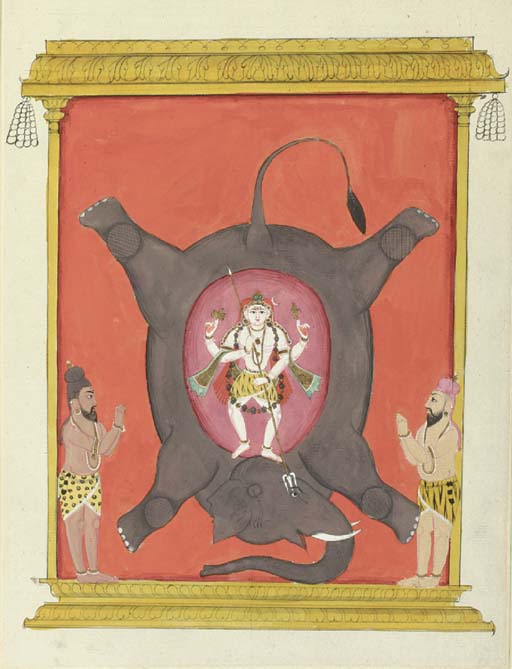

A Company School painting of an image from the temple of Trichinopoly, c.1810
Source: http://www.christies.com/LotFinder/search/LotDetail.asp?sid=&intObjectID=3934629&SE=CMWCAT03+244782+%2D253347858+&QR=M+1+0+Aqc0000900+220268++Aqc0000900+&entry=trichinopoly&SU=1&RQ=False&AN=1
(downloaded May 2002)
"COMPANY PAINTING -- TRICHINOPOLY SCHOOL [Hindoo Idols in the Pagoda of Tritchinipoly. Trichinopoly, southern India: c.1810].
Broadsheet (540 x 360mm). An album of 45 watercolours of the Hindu deities,
on paper, many heightened in gold, each approximately 350 x 250mm (watermarked
crowned J. Honig) and set in paper window mounts (watermarked Whatman 1833)
(First three and last two watercolours lightly spotted, some offsetting
and browning of interleaves. Brown morocco, gilt, by J. Wright, covers
with ruled borders enclosing broad sémé of thistle, floral
and swag-tooled motifs, spine in six compartments, raised bands, lettered
in the second 'Hindu Idols in the Pagoda of Tritchinipoly', others gilt,
gilt edges (endpapers browned). An attractive and particularly large
series of watercolours depicting the various deities at the Black Pagoda
at Trichinopoly, commissioned by a European from a local artist. Trichinopoly
was taken by Lord Clive in 1752 and remained an important garrison for
the British forces in India for 100 years. The large range of deities in
this album depicted include Shiva, Ganesha, Kartikeya, Rama, Parvati, Krishna
and Vishnu amongst others. The album begins with Shivite images and continues
with Vishnavite and ends with a series of Krishna scenes of the Bhagavata
Purana. This album was probably acquired by an English engineer or officer
in Southern India around 1810 and brought back to England soon after. The
presentation and binding was executed by J. Wright in London around 1833.
Although most Europeans in India favoured watercolours of views, and Indian
customs by "Company painters", the traditional deities of Hinduism held
a particular fascination for others. This is a fine example of this type
of art, and the inclusion of lotus flowers growing into the frames suggesting
a more western or Persian influences on this traditional Indian art."